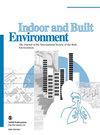The association of voice problems with exposure to indoor air contaminants in health care centres – the effect of remediation on symptom prevalence: A follow-up study
IF 2.9
3区 工程技术
Q2 CONSTRUCTION & BUILDING TECHNOLOGY
引用次数: 0
Abstract
Voice problems are common in occupations where there is noise, dust, odours or fumes and microbial contamination. The purpose of this study is to find out the prevalence of hoarseness, its changes over the follow-up and the effect of the remediation on the prevalence. A total of 13 health care buildings were followed, 10 with indoor air problems and 3 as reference buildings. Three buildings were thoroughly remediated, and their effects were analyzed. A health questionnaire was used, before and after the remediation. Blood samples and skin prick tests were performed on all volunteers. Based on findings, 17.0% of the respondents reported hoarseness at least every week. The skin test findings for common environmental allergens, moisture damage microbes and mites were approximately similar in the exposed and reference groups, respectively. Hoarseness had a strong correlation with indoor air problems. Before the remediation, hoarseness and voice problems were more prevalent in the problem buildings. After the remediation, hoarseness was reduced by 50%. In conclusion, this study shows a connection between indoor air exposure and technical damage in buildings. The remediation significantly reduced the prevalence of hoarseness. Mould allergy is rare and does not explain the voice problems.声音问题与卫生保健中心暴露于室内空气污染物的关系——补救措施对症状流行率的影响:一项后续研究
在有噪音、灰尘、气味或烟雾和微生物污染的职业中,声音问题很常见。本研究的目的是了解沙哑的患病率,其在随访中的变化以及修复对患病率的影响。共有13栋卫生保健建筑被跟踪调查,其中10栋存在室内空气问题,3栋作为参考建筑。对三栋建筑进行了全面整治,并对其效果进行了分析。在补救之前和之后使用了健康问卷。对所有志愿者进行了血液样本和皮肤点刺试验。根据调查结果,17.0%的受访者至少每周报告一次声音嘶哑。在暴露组和参照组中,常见环境过敏原、湿气损害微生物和螨虫的皮肤试验结果分别大致相似。声音嘶哑与室内空气问题密切相关。在修复之前,沙哑和声音问题在问题建筑中更为普遍。修复后,声音减少了50%。总之,这项研究表明室内空气暴露与建筑物的技术损害之间存在联系。补救措施显著降低了声音嘶哑的患病率。霉菌过敏是罕见的,不能解释声音问题。
本文章由计算机程序翻译,如有差异,请以英文原文为准。
求助全文
约1分钟内获得全文
求助全文
来源期刊

Indoor and Built Environment
环境科学-工程:环境
CiteScore
6.40
自引率
25.00%
发文量
130
审稿时长
2.6 months
期刊介绍:
Indoor and Built Environment publishes reports on any topic pertaining to the quality of the indoor and built environment, and how these might effect the health, performance, efficiency and comfort of persons living or working there. Topics range from urban infrastructure, design of buildings, and materials used to laboratory studies including building airflow simulations and health effects. This journal is a member of the Committee on Publication Ethics (COPE).
 求助内容:
求助内容: 应助结果提醒方式:
应助结果提醒方式:


